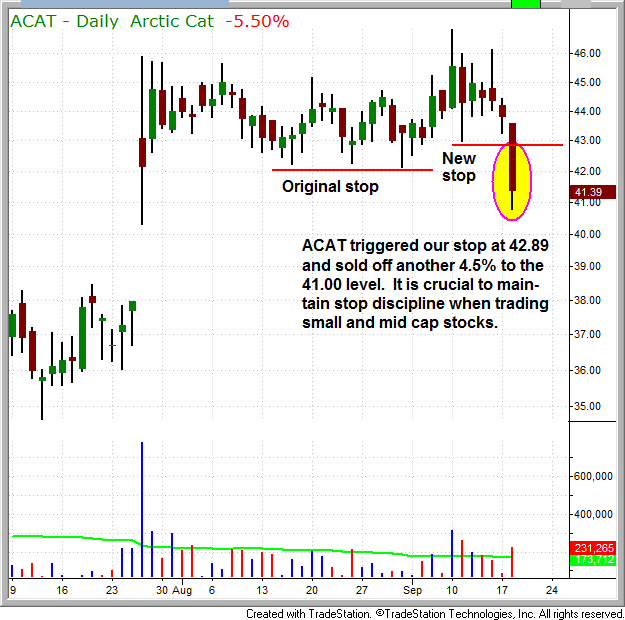In this popular post from yesterday, we discussed a common money management mistake among both new and experienced traders, specifically with regard to prematurely raising stops without an objective, technical reason. Today, we discuss a different, and even more dangerous, trade management mistake. It is the opposite problem, which is the much more dangerous mistake of failing to honor your protective stops when they are triggered.
Our swing trading system for stocks focuses on identifying explosive breakouts primarily in small and mid-cap stocks, in which these stocks typically gain 10% to 20% over a 1 – 4 week period. In order to achieve these type of gains, the stocks we swing trade are typically high beta,with plenty of volatility. Note that this is different than our ETF trading strategy, which is slower-paced and lower-volatility. The combination of trading both individual stocks and ETFs in our trading newsletter works well, as it smooths out the month-to-month volatility in our model portfolio.
By identifying low-risk entry points in leading individual stocks, we are able to use high volatility to our advantage because we look for stocks engaged in a volatility contraction, which are due for an inevitable range expansion within a few days. Because of this, when these stock trades do not quickly move in our favor, and reverse substantially lower instead, it is extremely important to always have preset, clearly defined protective stops in place. A good example of this is with the price action of both $ACAT and $ALLT yesterday.
Going into yesterday’s session (September 18), we were long both ACAT and ALLT in our newsletter (among other positions). However, both trades moved against us yesterday and hit our preset stop prices (we also sold two winning trades yesterday, $LNKD and $ALNY, which were larger than the losing trades). On the daily chart of $ACAT below, notice that the stock fell another 4% intraday after hitting our stop price:

Although the chart of $ALLT is not shown in this post, the importance of sticking to predefined stop prices was even more apparent with that trade, as the stock plunged another 7% intraday after we closed the trade upon hitting our stop price. With $ACAT and $ALLT falling substantially lower after hitting our stop prices just on an intraday basis, odds are good these stocks may move even lower in the coming days, which would trigger the deadly emotion of hope for traders who failed to sell at the proper exit point.
Failure to honor a stop is often the result of the trader falling into hope mode. Conversely, making an emotional decision to exit a falling trade before hitting its actual stop price (as discussed in yesterday’s post) is typically result of the powerful emotion of fear. Understanding and maintaining firm control on the human psychological emotions that drive stock markets is crucial for both new and experienced traders to understand. As such, you may wish to review an article I recently wrote on The Four Most Powerful Emotions For Stock Market Traders (greed, fear, greed, hope and regret).
The bottom line is we must always maintain extreme discipline to adhere to stop prices when executing our trading system, or else the dollar amount of the average losing trades will be larger than the winning trades. If that happens, being a consistently profitable trader over the long-term is not possible. This simply means we can not and do not hesitate to sell a stock or ETF whenever our stop price is triggered.
